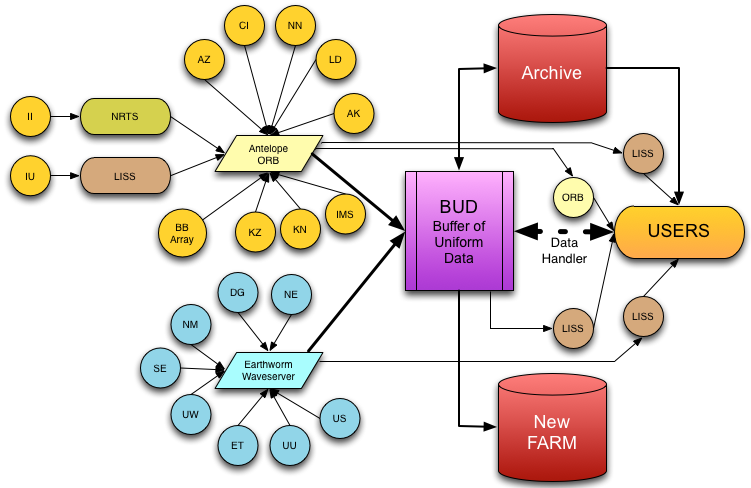Real Time Data Access through the IRIS DMC
As mentioned in our feature article, the IRIS DMC is presently receiving data from the Antelope and Earthworm systems. Currently there are at least 5 protocols and data formats used within IRIS to access real time data including:
- Earthworm
- Antelope
- LISS
- NRTS
- CD-1 protocol from the International Monitoring System (IMS).
A research seismologist hoping to receive data in real time would either have to install software to receive data from all of these methods or limit themselves to a subset of available data. A goal of the IRIS DMC is to simplify this model by absorbing all real time data available through these mechanisms and placing them into a large buffer at the IRIS DMC in a manner that makes data available from the DMC through simple and easy to use techniques.
The following diagram shows the data sources that we are presently receiving, or soon expect to be receiving, in near-real time. Data from Antelope ORBs have been arriving for several months at the DMC and we have just recently begun testing data retrieval from an Earthworm Waveserver system. We are currently ingesting data from AFTAC in CD-1 protocol, the IRIS/USGS GSN data, and the IRIS/IDA GSN data using the Antelope system. All of these data are reformatted to miniSEED data as needed and stored in a large Redundant Array of Inexpensive Disk (RAID ) system in a uniform manner (BUD).

Our initial efforts have been focussed toward developing a new way to build data products that will become part of the new FARM and SPYDER® systems. This system is currently working and will insure that the data in the FARM is always as complete as possible. Some development work remains to be completed before we can expect to support user data access. (For instance, the WILBER interface must be reworked to support the new FARM and SPYDER® systems.)
We plan to offer access to the real time data streams through a variety of techniques. Initially these include ORB to ORB transfers (see the Antelope article in this Newsletter), through LISS connections from the BUD (and perhaps connections from Earthworm and Antelope). Ultimately we are developing a Data Handler, in conjunction with the University of South Carolina, that will allow users to dynamically configure the seismograms they “order” in real time, in a playback mode, or from the archive. The Data Handler will:
- select the time series requested,
- transmit the data to the client’s machine,
- store the data in a selected format (SAC, AH, miniSEED, etc.) and
- if desired pipe the data directly into a processing sequence on the user’s own computer.
We anticipate the release of this system sometime next year. The Data Handler system will allow access to metadata held within the DMC’s Oracle Database, data in the archive, data in the FARM and SPYDER® volumes, or data being received in real time.
by Tim Ahern (IRIS Data Management Center)






